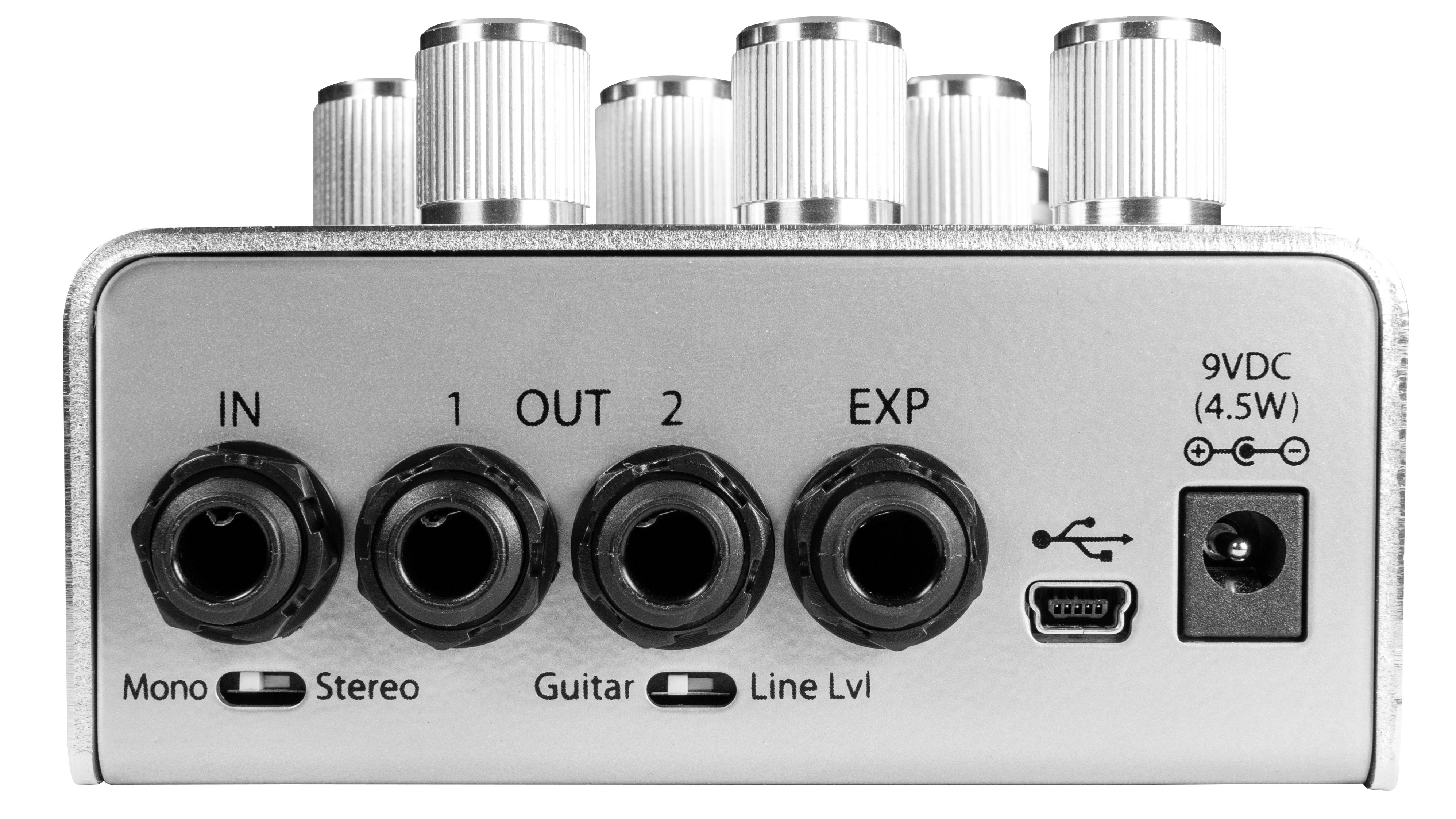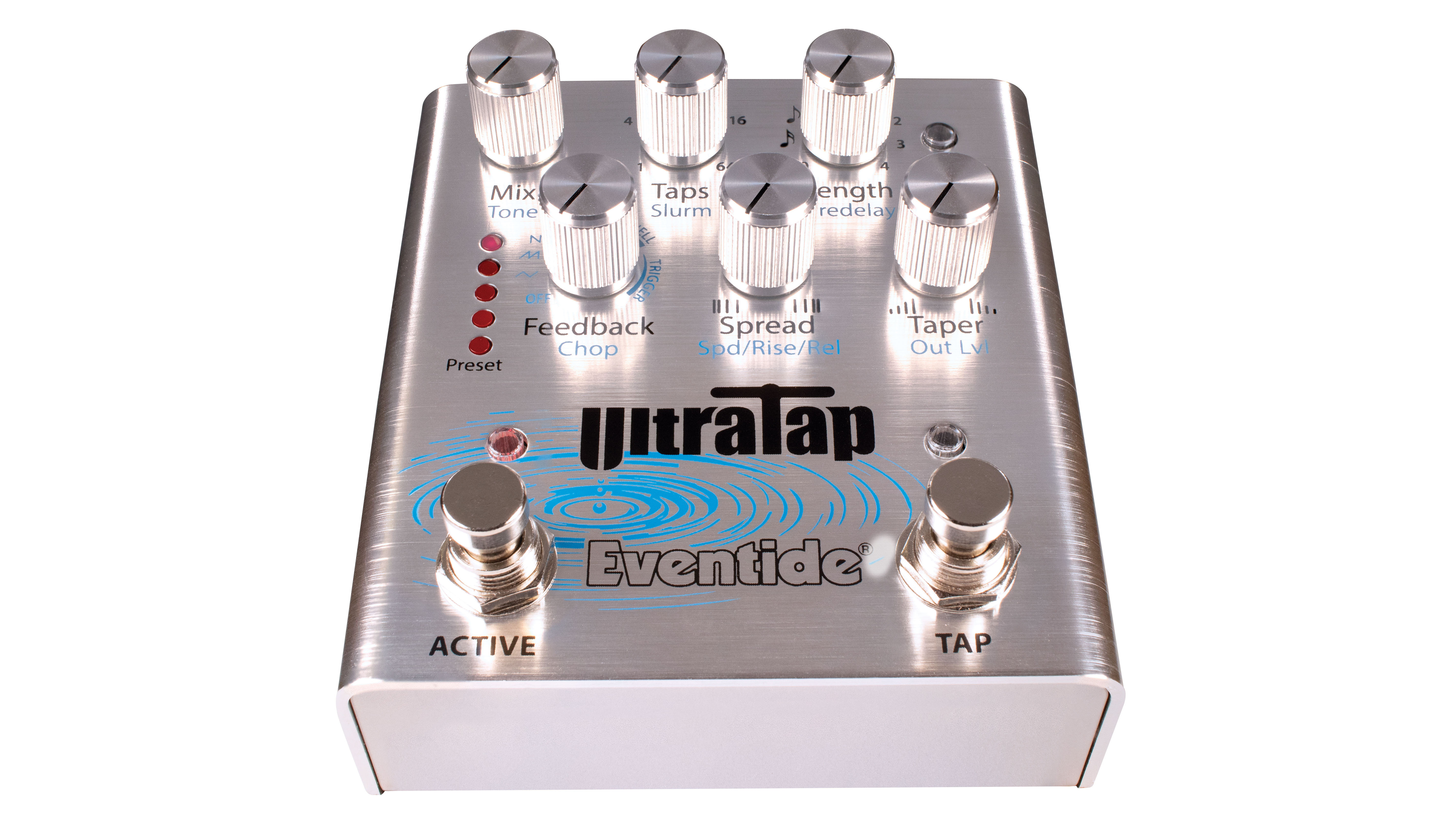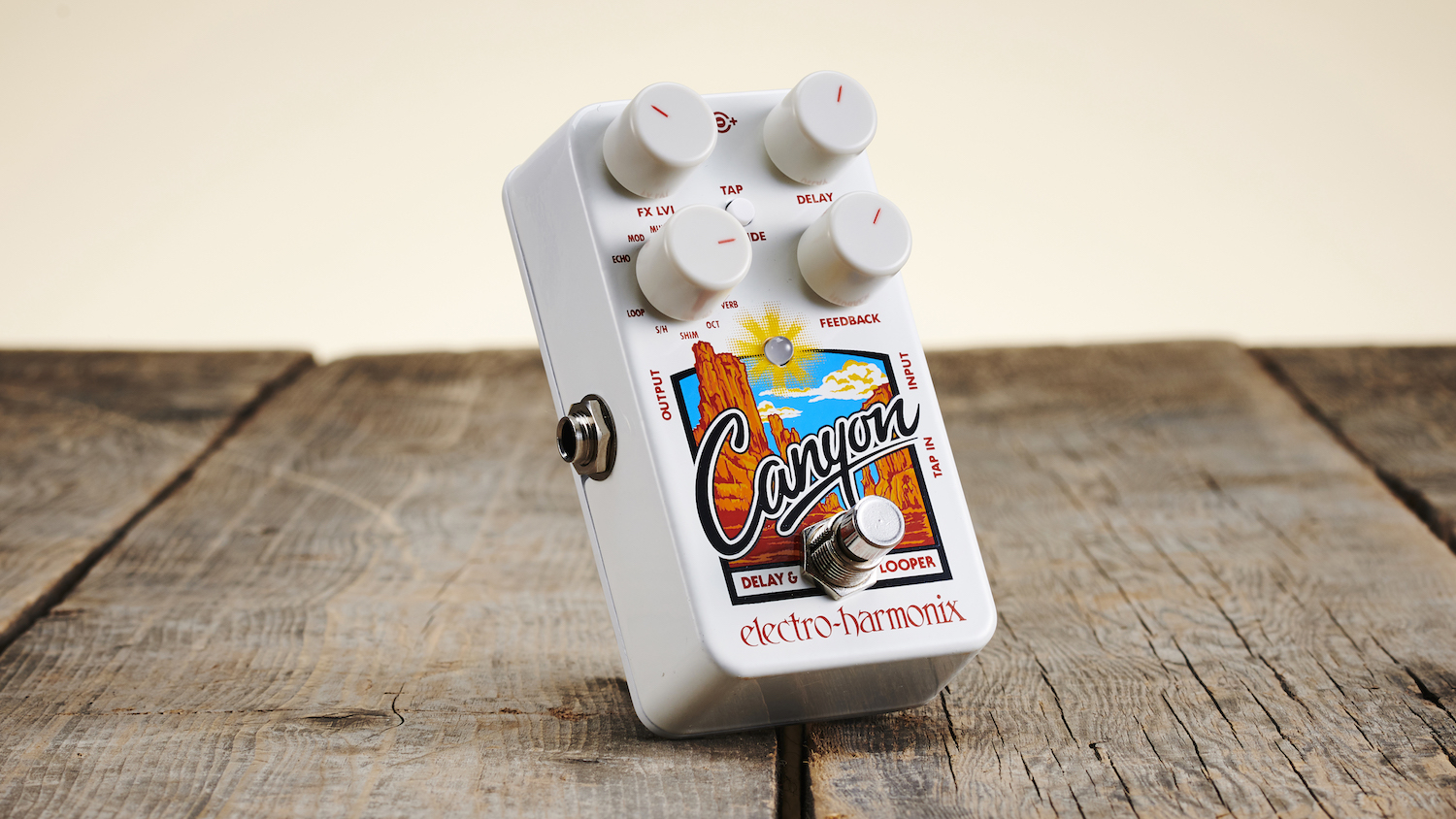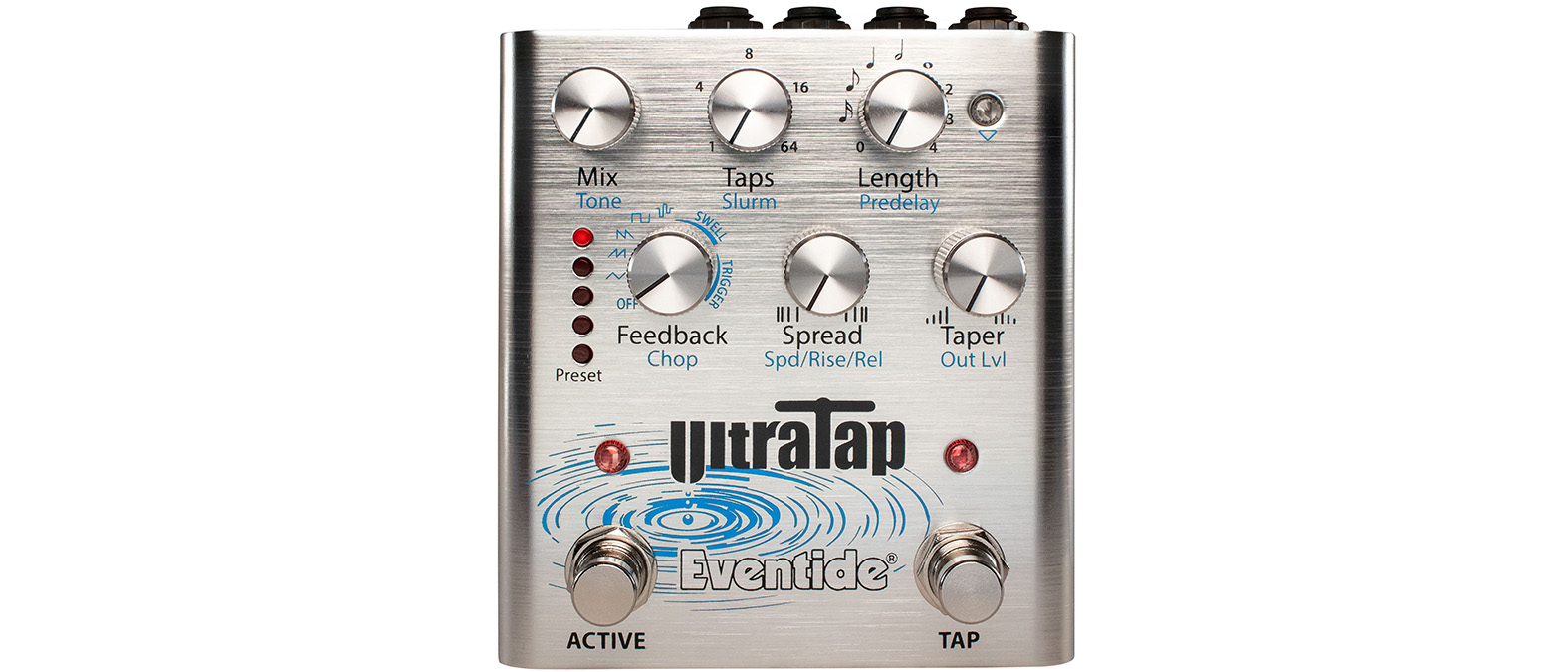MusicRadar Verdict
We think the UltraTap is a lot of pedal for your investment; a creative tool that progressive players will find plenty of inspiration in, and a treat for fans of ambient, versatile multi-tap delay sounds.
Pros
- +
Huge range of ambient or subtle delays.
- +
Deep editing through 12 parameters.
- +
Versatility to blur the lines with other effect sounds.
Cons
- -
A Micro USB and not USB-C connection is slightly odd in 2021.
MusicRadar's got your back
What is it?
Eventide's second delay pedal of 2021 is also the third in its dot9 series; bringing the company's iconic algorithms into standalone compact pedal form. The MicroPitch Delay and Blackhole reverb have already impressed us but there's always room for more on our testing table, so it's time to reacquaint ourselves with Eventide's UltraTap and find out how well it's integrated into an effects pedal.
Of course, some of you out there may already be familiar with it – the UltraTap is available as a plugin and can be found on the current Max version of the Eventide H9 Harmonizer stompbox. But its history goes back further to the multi-tap delay on the Eventide SP2016 in 1983 – the first programmable modular effects processor.
The trailblazing US company took multi-tap delay into new sonic spaces; literally. Creative tap spacing was introduced, allowing musicians to shape the volume envelope of multi-tap delays that went beyond Echoplex expectations. Then the iconic H3000 effects processor was the first to include an algorithm with the name Ultra-tap. This began an evolution that brings us to the UltraTap pedal with a capability of processing a whopping 64 taps and a huge palette of parameters for experimenting with to create fresh sounds.

It's a delay effect where the delay time can be subdivided into taps – multiples that allow for rhythmic and ambient delays with the manipulation of the tap spacing and their sonic character.
The UltraTap is not just a silver machine for travelling to the outer limits of delay editing. Like the MicroPitch, Eventide state there's scope for a really wide range of sounds here, including more traditional delays, unusual reverbs and choppy rhythmical repeats. So let's find how well it works in practice.
Like the MicroPitch, there's a total of 12 parameters you can edit here with six knobs performing double duty via an LED switch. As we pointed out with the MicroPitch, this level control offers deep editing and this is another pedal that needs and rewards time invested in learning and understanding its capabilities. Let's take a tour to understand them better.
UltraTap parameters explained
- Mix: The Wet/Dry mix, so fully turned up is an all wet signal.
- Taps: The number of delay taps, from 1 to 64 .
- Length: Total time over which the taps are spaced, up to 10 seconds.
- Pre-delay: The amount of time before the taps start, this can be set up to one second
- Feedback: Repeats of a Length-valued delay that is fed back around the entire multi-tap machine.
- Spread: This is the rhythmic spacing of the taps. Eventide states, "More negative values (anti-clockwise from noon on the dial) will group taps towards the beginning for a 'slowing-down' feeling. More positive values will group taps towards the end for a 'speeding-up' delay sound."
- Taper: Controls the fade of the taps with negative values increasingly giving a fade-up over the taps and more positive giving a fade-up .
- Tone: Negative values for darker sounding taps, positive for brighter.
- Slurm: Slurring/smearing/ modulation – "Adds juicy tap slurring/smearing and modulation," says Eventide.
- Chop: Pre-tap-machine chopping tremolo OR auto-volume processor with several waveform choices: Off, Triangle, Sawtooth, Ramp, Square, or a randomised sample and Hold. The auto-volume processor will either do volume swells or a gating effect, called Trigger, that chops off the end of sounds. These both have 0-9 sensitivity levels you can set.
- Speed, Rise, Release: Affects the Chop – Speed changes LFO speed, Rise adjusts Swell rise time and Release is for Chop Trigger – setting the amount of time after triggering before the gate kicks in and chokes off the sound.

Performance and verdict
Mix and Taps (repeats) will be familiar to delay users but there's plenty here that highlights just how distinct Eventide's offering is; Slurm, Chop, Spread, Taper… all suggest a new world for many of us. Truth be told, there are a lot of delays bringing their own bespoke parameters to the market, but Eventide's depth of editing on the character of repeats here is notable.
This is a pedal that dives deep into ambience with its multi-tap editing; the way note attack and taps can be manipulated makes the UltraTap the delay sibling to the Blackhole reverb pedal for us.
Want all the hottest music and gear news, reviews, deals, features and more, direct to your inbox? Sign up here.
The five onboard presets give a good indication of the range it's capable of (though there's 50 more to download via connection to Eventide's Device Manager software). Like the MicroPitch, each onboard preset has a template card that slides over the UltraTap to show you what level each of the 12 settings is at. For example, Preset 3's Ultraswole sounds like an eerie slow attack in reverse with the Taps and Slurm controls maxed and Chop set to Swell. Preset 4's Glitchtrigger has the Chop parameter set to Trigger and Taps to around 6 for a watery texture on sustaining notes.
The Chop control's Trigger can cut off the end of your notes to dramatic effect but set it to the saw LFO waveform while on Preset 5's Trembience and it sounds just like the synth intro to the Stereophonics' Dakota!
Hence, the Presets are great starting points for experimenting with each parameter. Turning the Chop off and turning up the Length with Spread set at noon allows long moody sustain to be unleashed and it's great for single note atmospheres.
The Slurm control's 'smearing' of taps is one of this pedal's most addictive calling cards
But like the MicroPitch, there are also more subtle textures to be discovered that aren't just for the cinematic show-stopping moments. Keeping the Tap at 1 like a standard delay, Slurm on 0 and Length at around 4 pm for a slapback is a good starting point to investigate out from. Add some subtle short-length texture for character.
Slurm, Chop and Speed/Rise/Release are your tickets into deep ambience. Once you've decided on your tap number and time between them of course; because this is what they manipulate. You can keep your taps ordered and use Chop to shape that character with watery and metallic results, but the Slurm control's 'smearing' of taps is one of this pedal's most addictive calling cards.

It produces some wonderful results, with the Taper control brightening or darkening the detail of your taps' fades. You'll find happy accidents, but it really repays time investment if you don't want to dive in via the presets. This is when you can use the UltraTap to create parts, rather than simply colouring them.

Our pick of the best delay guitar effects from Boss, Strymon, Electro-Harmonix and more
The UltraTap's versatility for entering the territory of other effects shouldn't be overlooked either; turning taps down to 1, we used the Chop for a tremolo effect. This is more than delay, though you can certainly get it into Edge, four-head echo and slapback with some tinkering. There's some superb delay for lead lines to be found with the saw wave Chop too, using the Slurm as a kind of reverb and the Taper to bring taps levels progressively up or down. There's a lot here to discover.
The best effects are those we can get lost in and Eventide has created another inviting portal here. If you want simple tape echo or digital delay, there are more suitable options out there. If you'd like to explore a wide range of subtle and ambient multi-tap delay sounds for your guitar (or synth and drums) with elements of reverb and modulation, dive in here!
There's more than enough capability in the UltraTap to justify the standalone treatment
The only hesitant question hanging over the UltraTap, if we can even call it that, is Eventide's own product line. The Blackhole, MicroPitch and UltraTap are great standalone pedals, but Eventide's fully-loaded H9 Max unit is on the market (unless you can find an older, cheaper H9 series pedal) offering all those algorithms and more for less than the price of buying all three dot9 series pedals from the street prices we've seen. Of course, that's still a significant outlay and some players may prefer the dedicated control approach here. There's more than enough capability in the UltraTap to justify the standalone treatment.
MusicRadar verdict: We think the UltraTap is a lot of pedal for your investment; a creative tool that progressive players will find plenty of inspiration in, and a treat for fans of ambient, versatile multi-tap delay sounds.
Hands-on demos
Mike Hermans
Eventide
Leon Todd
Pete Thorn
Sweetwater
Specifications
- ORIGIN: China
- TYPE: Multi-tap delay pedal
- FEATURES: Multiple Bypass options (Buffered, Relay, DSP+FX or Kill dry), MIDI, 5 onboard presets, software editor, Dual-action Active Footswitch for latching or momentary
- CONTROLS: Mix/Tone, Taps/Slurm, Length/Predelay, Feedback/Chop, Spread / Speed, Rise, Release, Taper / Out Level, Tap in seconds or BPM/Preset Select Mode LED Button, Active LED Button to switch between Active Footswitch and Momentary modes, Active and Tap footswitches.
- CONNECTIONS: Input 1/4" TRS / Mono Tip, Stereo Tip and Ring, Output 1 and 2 1/4" TS Mono / Mono, Expression pedal input 1/4" TRS, Aux Switch or MIDI I/O, Mini USB
- POWER: Included 9V DC adaptor, 200mA
- DIMENSIONS: 178 (w) x 121 (d) x 71mm (h)
- CONTACT: Eventide Audio
MusicRadar is the number one website for music-makers of all kinds, be they guitarists, drummers, keyboard players, DJs or producers...
- GEAR: We help musicians find the best gear with top-ranking gear round-ups and high-quality, authoritative reviews by a wide team of highly experienced experts.
- TIPS: We also provide tuition, from bite-sized tips to advanced work-outs and guidance from recognised musicians and stars.
- STARS: We talk to musicians and stars about their creative processes, and the nuts and bolts of their gear and technique. We give fans an insight into the craft of music-making that no other music website can.

